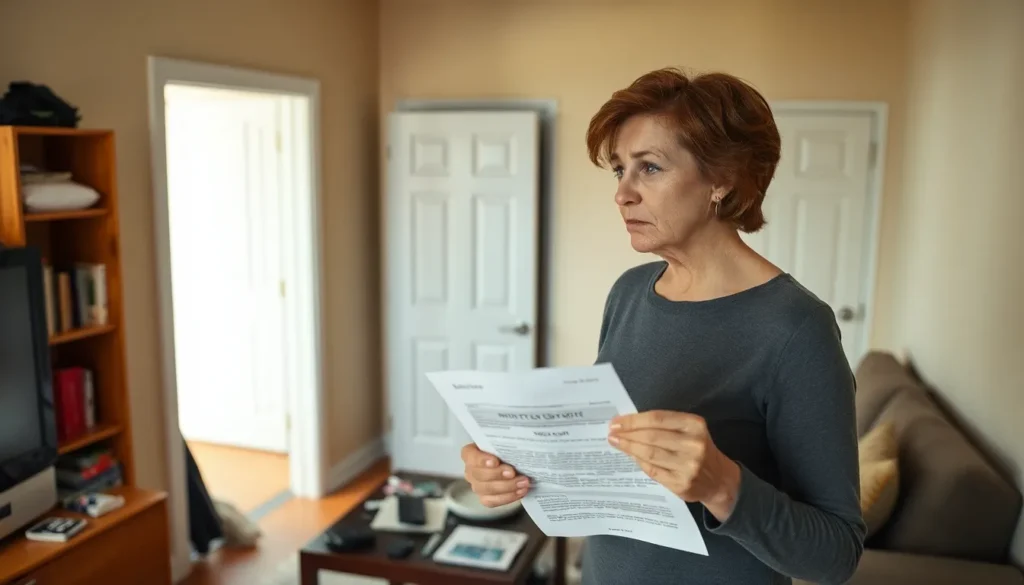Table of Contents
ToggleWhen it comes to securing a loan, understanding the loan-to-value (LTV) ratio is like knowing the secret handshake to the financial club. It’s that magical number that lenders scrutinize to determine how much risk they’re willing to take on. Think of it as the financial equivalent of a dating profile—too high, and they might swipe left; too low, and you’re golden.
Understanding Loan-To-Value Ratio
The loan-to-value (LTV) ratio represents the relationship between a loan amount and the appraised value of the property. This ratio is crucial for lenders when evaluating risk in mortgage applications.
Definition of Loan-To-Value Ratio
The loan-to-value ratio calculates the percentage of a property’s value that is financed through a loan. It is expressed as:
[
text{LTV} = left( frac{text{Loan Amount}}{text{Property Value}} right) times 100
]
A higher LTV indicates a larger loan relative to the property’s worth. For example, an LTV of 80% means the borrower finances $80,000 of a $100,000 home. Lenders use this ratio to assess potential risk, as a higher percentage often signifies greater risk of default.
Importance in Real Estate
In real estate, the loan-to-value ratio plays a vital role in determining mortgage terms. Lenders typically favor lower LTV ratios since they signify less risk. An LTV of 60% often secures better interest rates and terms compared to higher ratios. Borrowers with lower LTV ratios may also avoid private mortgage insurance (PMI), leading to substantial savings. For first-time homebuyers, understanding LTV helps gauge affordability and expectations during the mortgage process.
How to Calculate Loan-To-Value Ratio
Calculating the loan-to-value (LTV) ratio is straightforward. This ratio expresses the loan amount as a percentage of the property’s appraised value.
Step-by-Step Calculation
- Identify Loan Amount: Determine the total amount being borrowed for the property.
- Find Property Value: Obtain the appraised value of the property, usually through a home appraisal.
- Use the Formula: Apply the formula: LTV = (Loan Amount / Property Value) x 100.
- Calculate Percentage: Multiply the result by 100 to convert it into a percentage.
This formula highlights how much of the property’s value is financed through the loan.
Examples of Calculation
For instance, consider a home appraised at $300,000. If the loan amount is $240,000, then the LTV calculation would be: (240,000 / 300,000) x 100.
This results in an LTV of 80%. Another example: for a property valued at $200,000 with a loan of $150,000, the calculation yields an LTV of 75%.
These examples illustrate how the LTV ratio helps lenders assess borrower’s risk profiles, influencing mortgage terms and rates.
Factors Influencing Loan-To-Value Ratio
Understanding the factors that influence the loan-to-value (LTV) ratio is essential for borrowers. Two primary components dictate this ratio: property value and loan amount.
Property Value
Property value plays a critical role in determining the LTV ratio. An appraiser evaluates the property, considering factors like location, condition, and comparable sales. A higher appraisal increases the property’s worth, resulting in a lower LTV if the loan amount remains constant. Conversely, if the property value decreases, the LTV ratio rises, heightening the perceived risk for lenders. Accurate property valuation is essential, as lenders rely on it to make informed decisions about loan approvals and terms. This process underscores the importance of detailed appraisals in the mortgage application process.
Loan Amount
The loan amount directly impacts the LTV ratio. A higher loan leads to a greater ratio percentage when paired with a fixed property value. Borrowers seeking larger loans must recognize the increased risk that lenders associate with high LTV ratios. A loan amount that is too large can limit options for lower interest rates and favorable terms. Lowering the loan amount can enhance eligibility for better mortgage rates and minimize the necessity for private mortgage insurance (PMI). Borrowers should strategize their financing approaches to achieve a more favorable LTV ratio.
Benefits of a Favorable Loan-To-Value Ratio
A favorable loan-to-value (LTV) ratio provides several significant advantages for borrowers. Lower LTV ratios often lead to better interest rates, which can substantially reduce overall loan costs. This reduction translates into lower monthly payments, making loans more manageable.
Access to more loan options frequently occurs with lower LTV ratios. Lenders view these borrowers as less risky, resulting in increased acceptance rates for various mortgage programs. They may also provide additional financing choices that higher LTV borrowers might not qualify for.
Another benefit includes the potential to avoid private mortgage insurance (PMI). Homebuyers with LTV ratios below 80% usually don’t face this extra cost, leading to greater overall savings throughout the loan term. Eliminating PMI further enhances affordability and maximizes purchasing power.
Enhanced negotiation power arises from a favorable LTV ratio as well. Borrowers can leverage their financial standing to negotiate better terms, including lower fees or more favorable payment plans. Lenders may express willingness to offer incentives to lower-risk applicants.
Protecting equity remains vital for homeowners. Favorable LTV ratios help maintain equity, minimizing the risk of being underwater during market fluctuations. Stable equity supports long-term financial health and offers homeowners the option to access cash through refinancing if needed.
Maintaining a favorable loan-to-value ratio significantly impacts a borrower’s financial landscape. It directly influences interest rates, loan options, and overall savings. Understanding these benefits aids borrowers in making informed decisions during the mortgage process.
Risks of a High Loan-To-Value Ratio
High loan-to-value (LTV) ratios present several risks for borrowers. They often result in higher monthly payments due to increased interest rates. Lenders view high LTV ratios as a sign of greater risk, leading to more stringent loan conditions.
Loan options may also become limited for those with elevated LTVs. Some lenders may decline applications, fearing potential default situations. Borrowers face challenges when attempting to refinance if their LTV remains high.
Financial strain can occur, especially if housing market values decline. A drop in property value raises the LTV ratio further, increasing the likelihood of being underwater, where owed mortgage amounts surpass property value. This financial vulnerability can lead to foreclosure if borrowers cannot meet payment obligations.
Private mortgage insurance (PMI) becomes essential for those with LTV ratios above 80%. This additional cost can significantly increase overall loan expenses. Borrowers must factor this expense into their budgets, which can limit financial flexibility.
Lastly, a high LTV ratio may impose restrictions on future borrowing. Lenders often assess past borrowing behavior, and a high LTV ratio can signal potential instability or risk. This situation may affect chances of securing other forms of credit in the future.
Overall, understanding the implications of a high LTV ratio ensures informed decision-making during the borrowing process.
Conclusion
Navigating the loan-to-value ratio is essential for anyone entering the mortgage market. A favorable LTV ratio not only opens doors to better interest rates but also enhances the overall borrowing experience. By understanding how LTV impacts loan approval and terms borrowers can make more informed financial decisions.
Maintaining a lower LTV can lead to significant savings and greater financial stability in the long run. It’s crucial for borrowers to assess their LTV ratio and strategize accordingly to secure the best possible mortgage terms. This knowledge empowers them to make choices that align with their financial goals and future plans.








